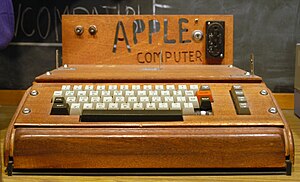Apple I

A fully assembled Apple I computer with a homemade wooden computer case
|
|
| Also known as | Ruby |
|---|---|
| Developer | Steve Wozniak |
| Type | Personal computer |
| Release date | April 11, 1976 |
| Introductory price | US$666.66 (equivalent to $2,806 in 2016) |
| Discontinued | September 30, 1977 |
| CPU | MOS 6502 @ 1 MHz |
| Memory | 4 KB standard expandable to 8 KB or 48 KB using expansion cards |
| Graphics | 40×24 characters, hardware-implemented scrolling |
| Successor | Apple II |
Apple Computer 1, also known later as the Apple I, or Apple-1, is a desktop computer released by the Apple Computer Company (now Apple Inc.) in 1976. It was designed and hand-built by Steve Wozniak. Wozniak's friend Steve Jobs had the idea of selling the computer. The Apple I was Apple's first product, and to finance its creation, Jobs sold his only motorized means of transportation, a VW Microbus, for a few hundred dollars, and Wozniak sold his HP-65 calculator for $500; however, Wozniak said that Jobs planned to use his bicycle if necessary. It was demonstrated in July 1976 at the Homebrew Computer Club in Palo Alto, California.
Production was discontinued on September 30, 1977, after the June 10, 1977, introduction of its successor, the Apple II, which Byte magazine referred to as part of the "1977 Trinity" of personal computing (along with the PET 2001 and the TRS-80).
On March 5, 1975, Steve Wozniak attended the first meeting of the Homebrew Computer Club in Gordon French's garage. He was so inspired that he immediately set to work on what would become the Apple I computer. After building it for himself and showing it at the Club, he and Steve Jobs gave out schematics (technical designs) for the computer to interested club members and even helped some of them build and test out copies. Then, Steve Jobs suggested that they design and sell a single etched and silkscreened circuit board—just the bare board, no electronic parts—that people could use to build the computers. Wozniak calculated that having the board design laid out would cost $1,000 and manufacturing would cost another $20 per board; he hoped to recoup his costs if 50 people bought the boards for $40 each. To fund this small venture, their first company, Jobs sold his van and Wozniak sold his HP-65 calculator. Very soon after, Steve Jobs arranged to sell "something like 100" completely built computers to the The Byte Shop (a computer store in Mountain View, California) at $500 each. To fulfill the $50,000 order, they obtained $20,000 in parts at 30 days net and delivered the finished product in 10 days.
...
Wikipedia
